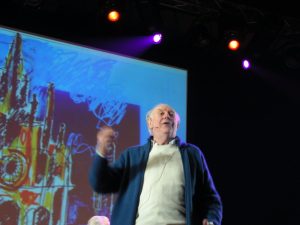I
Just as so many other literary-historical labels, concrete poetry, it seems, is what we make of it, what we include and exclude, where and what against we draw the line. This provisional and necessarily pragmatic character of the activity need not be regarded its weak spot, indeed rather to the contrary, at least according to Mary Ellen Solt and Emmett Williams, editors of two seminal anthologies of the early post-WWII concrete poetry. This indefinability is what concrete poetry has thrived on, what contributed to its mass followership and longevity. Yet at the same time, this multiplicity has also given license to blanket dismissals that target particular tendencies or subgroup idiosyncrasies as emblematic of the entire concretist poetics and sensibility.
Notes Solt,
“there are now so many kinds of experimental poetry being labeled ‘concrete’ that it is difficult to say what the word means,”
and Emmett points out that, via its label as “picture poetry”, concretism has been alternately associated with and referred back to “the calligrammes of Apollinaire, the mouse’s tail in Alice, the permutational poems of the cabalists, the anagrams of the early Christian monks, the carmina figurata of the Greek bucolic poets, picture-writing itself.” Both Solt & Williams point to how the adjective “concrete” is persistently confused with and treated as interchangeable with “sound,” “visual” or “kinetic” poetry; and both wonder to what extent even the largely accepted category of “poetry” can still apply here.
Still, both concur on an essential requirement that the various kinds of concrete poetry meet:
“concentration upon the physical material from which the poem or text is made.”
This concentration is marked by “a linguistic reduction” [words reduced to their elements of letters (to see) and syllables (to hear)], establishing this linguistic material in a new relationship to space (the page or its equivalent) and/or to time (abandoning the old linear measure), producing, for Solt, “an object to be perceived rather than read.” To which Williams adds that unlike traditional “picture-poetry,” the visual element in concrete poetry tends “to be structural, a consequence of the poem”, a “picture of the lines of force of the work itself, and not merely textural” – “a poetry of direct presentation.”
The plurality and ill-definability of the thing itself is matched by its radically decentred origins and polyphony of its programmatic articulations. The concrete poetry movement developed in just the fashion in which international literary movements are seldom supposed to. Although initiated by a Bolivian-born Swiss artist, Eugen Gomringer, concretism came into effect around the same time in literary peripheries all around the globe.
Writing and publishing first of what he would call not poems but “constellations” (in 1952-3), accompanied by a manifesto “from line to constellation” (in 1954), little was Gomringer aware that still in 1952, three poets in São Paulo, Brazil—Haroldo de Campos, Augusto de Campos and Décio Pignatari—formed a group for which they took the name from Ezra Pound’s Cantos, started writing a series of poems entitled “Poeta-menos” (“poet-minus”) and in 1955 referred to their activity as “poesia concreta.” To further confuse the issue, neither Gomringer nor the Campos brothers were conscious, at the time of their writing/manifesting, that Carlo Belloli of Italy had made and exhibited “Mural Text-Poems” as early as 1944, or that Oyvind Fahlström of Sweden had been writing concrete poems by 1952 and published a “Manifest for konkret poesie” in Swedish in 1953.
Bern, São Paulo, Stockholm… indeed, throughout its first two decades, concretism gained only a tenuous foothold in the centres of literary modernism and avant-gardism but continued to flourish in its outposts. Its centres of activity were not New York, Paris and Berlin, but places like Darmstadt, Toronto, Tokyo, Vienna, or the politically isolated socialist Prague. Why concretism happened exactly at the time and in the sort of places it did, and what its formal goals and achievements were, are still the basic unanswered questions about this peculiar episode in post-WWII literary modernism, one seldom tackled by literary scholarship.
For instance, Marjorie Perloff, in her recent essay on “The Legacy of Brazilian Concrete Poetry,” describes concretism as solidifying the decades of modernist innovation, synthesising the pre-war achievements of the Euro-American avant-garde and already paving way for the future arts of multimedia or hypertext. Yet Perloff does little to account for why concrete poetry emerged in such a decentred, rhizomatic way, or why the movement and its poetics spread so rapidly and widely. Nor does it attempt to defend concretism from the not uncommon criticism that its “fusion of expression and content” was an instance of what Umberto Eco had termed the “iconic fallacy.” That is, the fallacy that
“a sign has the same properties as its object and is simultaneously similar to, analogous to, and motivated by its object.”
Perloff, though not voicing it herself, finds “compelling” the critique of early concretism which reduces it to a type of l’art-pour-l’artism naively believing in the unity of “word-sound/image-thing.” According to this line of reasoning, all concretism does—while claiming to intervene into the socio-political by changing the sign system—is rehash the avant-garde typographical and calligraphic aesthetics, only this time self-referentially and with no critical dimension.
II
That concretism should be criticised for a naïve Rousseauianism that seeks to bridge the gap between words and things, writing and speech, writing and act, is all the more ironic given that the movement’s seminal theoretical documents actively sought to pre-empt and refute this accusation. In their manifesto “Plana-piloto para Poesia Concreta,” (1958) the Brazilian trio of concretist forefathers define concretism as the
“tension of word-things in space-time.”
Echoing a coinage from Joyce’s Finnegans Wake, they call for concrete poetry opening up a “verbivocovisual linguistic area” that foregrounds the differing abilities of “digital” textual representation and “analogical” graphic design, but doesn’t seek any reconciliation between the two:
The phenomenon of metacommunication occurs with the concrete poem: coincidence and simultaneity of verbal and nonverbal communication; but—it must be noted—it deals with the communication of forms, of structure-content, not with the usual message communication.
It’s important to stop short of equating the “coincidence and simultaneity” of the phoneme and grapheme mentioned by de Campos speaks here, with their identity. Far from being a naïve instance of the iconic fallacy, then, concretism seeks to produce tension, and not reconciliation, among “word-things in space-time,” and in doing so, it calls for poetry “responsible before language,” whose “general art of the word” is opposed to the “hedonism of expression” in lyrical or confessional poetry:
Concrete poetry: total responsibility before language. Total realism. Against a subjective and hedonistic poetry of expression. To create precise problems and to solve them in terms of sensible language. A general art of the word. The poem-product: useful object.
To be sure, leafing through Williams’s anthology yields a fair amount of typographical visualism, semantic iconicity and mechanic permutations whose tensions don’t provide much food for conceptual thought and their effect is pictorial – among fitting examples would be Ian Hamilton Finlay’s “Acrobats” (Fig. I), whose effect consists in the metaphorically acrobatic leaps the viewer’s eye must take to comprehend the word:
Figure I. Ian Hamilton Finlay, “Acrobats” (1964)

Another instance of word-imagism would be Reinhard Döhl’s “Apfel” (Fig. II), where the seemingly continuous “Apfel” word-texture is iconically apple-shaped and has a textual intrusion in the form of “Wurm/worm”:
Figure II. Reinhard Döhl, “Apfel” (1965)

But the best of the early concrete poems remain visually and conceptually fascinating because their attempts to triangulate letters, sounds/images, and things never quite go smoothly. To take an example from outside the Noigandres group, let’s have recourse to a seminal classic by concretism’s European parent, Gomringer (Fig. III):
Figure III. Eugen Gomringer, “Silencio” (1954)

This concrete text is far more than a mere visual pun where typographical silence evokes silence as concept. Upon closer inspection, the idea of form fitting its content in “Silencio” appears highly problematic, marked by tension between the symbolic operations of the word “silence” and its iconic typographic realisation. In critic Sam Rowe’s reading of this Gomringer text:
“The term ‘silence’ posits the absence of something, is a negative rather than a positive description. The typographical silence adds to this by staging the absence of the word ‘silence’ itself. Strictly speaking, then, the absent center of the poem is more silent than silence.”
The obsessive repetition surrounding it is peculiarly verbose: its form consists in continuously rearticulating a designation of absence. The iconisation, in Gomringer’s poem, is undermined by at least two processes: on one hand, by positing something more silent than silence, a double negation with possibly a positive outcome; on the other, by repeating the word “silence” so assiduously as to render inaudible any silence that there might be to hear. There is, Rowe suggests, even a third level of incongruity given that “any printed text, and especially an unrecitable visual poem, does its work in silence,” and so, far from being a tidy illustration of the concept announced in its title,
“the poem strains toward an impossible feat of triple negation: a silence more silent than the articulate silence of printed words.”
Moreover, every now and then, amidst the myriad examples of this supposedly self-referential exercise in disengaged aestheticism, there lurks a committed concrete poem, critical of, for instance, the uses and abuses of design in advertising – for instance, Décio Pignatari’s “Cloaca” (Fig. IV):
Figure IV. Décio Pignatari, “Cloaca” (1957)

Pignatari’s text functions as a kind of anti-advertisement, a typical 1950s exercise in détournement, this time of the coca-cola advertisement slogan “beba” / “drink” coca-cola by introducing such disruptions as “babe” (“slob”) and “caco” (pieces/feces), and finally imploding the two brand words to form their near-perfect anagram, “cloaca.” The use of the iconic white typography against a red background doesn’t subtract or divert from the subtle wordplay and symbolic permutation of the poem’s text.
So far, this exploration and defense of concretism’s internationalist, conceptual and critical merits has taken place by means of texts in English, German, Spanish and Portuguese – and it’s plainer to aspire to the status of internationalism in a language spoken by tens and understood by hundreds of millions people. Concretism exceeds literalism and enhances the signifying potential of language by iconic means, thereby—as both its adherents and detractors alike contend—achieving its internationality and multilingualism. If this is so, then how do the methods differ when a language is concretised that is minor and, moreover—in the period under observation—finds itself in political isolation from the West?
III
Quite remarkably, Czechoslovakia features as the only Eastern-bloc country included in Solt’s World View anthology – there’s no Soviet, Chinese or Yugoslavian concretism represented in her volume. Solt herself explains the anomaly by referring both to native tradition and foreign influences – concretisation appears as
“a reaction against verbosity, literary affectation of style, sentimentality, pathos and emotionalism in traditional poetry,”
and also as consequence of most of the concrete poets’ translation activities. The pioneers of Czech concretism, Josef Hiršal (1920–2003) and Bohumila Grögerová (1921–2014), were both translators from German. The point, for them, was to fashion a new poetry involved with the actual mechanisms of language, to write poems that would show not only the image of the world but its schemes. That they should echo the sentiments of the Noigandres group is no coincidence – on his European tour of 1964, Haroldo de Campos did indeed make a stop in Prague in March 1964, giving a lecture at the Mánes gallery and appearing on the national radio.
Still, in keeping with the simultaneous non-linearity of concretist development, much of the first-generation Czech concretism preceded both de Campos’s visit or any indirect exposure to the Noigandres poetics. Ladislav Novák (1925-1999), author of the first Czech concretist collection, Homage to Jackson Pollock (1968) had been involved in semantic explorations of spatiality and permutation since at least the mid-50s. The collection—which was attacked in the official paper of the red right Rudé právo and yet sold out in Prague the day it was published—includes for instance a concretist sonnet, “Magic of a Summer Night,” (Fig. V):
Figure V. Ladislav Novák, “kouzlo letní noci”

Novák’s concretist text divides according to the grouping of its words into two parts: one of eight “lines” the other of six, like the sonnet. But, of course, they aren’t really lines. Were it not for the fact that “hma/tam” (which suggests “hmatám” – “I am touching”) emerges when the poem is “read” in the conventional way from left to right, it might conceivably be read downwards, or upwards. The bewildering, multi-directional symmetry of the four columns of three-letter words and word fragments conveys something of the disorientating spell of “the magic of a summer night.” In the last six “lines” the same concrete method of word repetition is employed with “srp” (sickle or scythe) juxtaposed with “prs,” which means “breast” and is also “srp” spelled backwards, thereby conveying the presence of a woman—and introducing erotic overtones—as well as the sense of the back and forth movement of the scythe (with a nearby “pes”/”dog” possibly howling through the hot night).
However, Novák’s sustained exploration of rich monolingual wordplay remains a rather solitary endeavour in the Czech context; far more common are graphic iconicity and multilingualism or self-translation. A proponent of the former is the well-known collage artist Jiří Kolář (1914-2002), who published Stignboard for Gersaint in 1962, a manifesto of what he termed evident poetry, defined as “all poetry that eschews the written word as the mainstay of creation and communication.” According to Kolář, “the word […] should remain within, instigating a monologue.” The evident poem is primarily a graphic statement – Kolář’s “Brancusi” (Fig. VI) needs neither comments nor word gloss, beyond pointing out the obvious iconic similarity to Brancusi’s famous “Bird in Space” (1928):
Figure VI. Jiří Kolář, “Brancusi” (1962) & Constantin Brancusi, “Bird in Space” (1928)

Somewhere in between the two tendencies stands Václav Havel (1936-2011), who—although known primarily as dramatist and essayist—did author a collection of “engaged” concrete poems published in 1964 as Anticodes. Examples here are the “Brněnský komplex”/“Brno Complex” and “Odcizení”/“Estrangement” (Fig. VII), both consisting of a single word only, their “engagement” with the human condition being largely visual and use of language minimalist:
Figure VII. Václav Havel, “Brněnský komplex,” “Odcizení” (1964)

Havel’s minimalism is, quite obviously, chiefly iconic: in “Brněnský komplex” it consists in deploying a single word “Praha”/Prague in the bottom-left corner of the page, representing Brno’s rivalry with the Czech capital as the suppressed/marginalised source of its own inferiority. “Odcizení” then features a labyrinthine pathway from “J” to “A,” forming “JÁ,” the Czech first-person pronoun.
Multilingualism is a staple device employed by both Hiršal and Grögerová, as evident in their early-60s experimental poems published under the title Job Boj (1968) where “boj” means “fight” or “action” and “job” not only mirrors “boj” by printing it backwards but echoes the notorious tragic biblical character. Each poem in job boj employs a different method (in fact, Hiršal and Grögerová categorise their texts into twelve chapters/subgenres), and their overall intent is to reveal the world as mixed up and chaotic, although generally speaking even those with a markedly semantic/symbolic function have a primarily visual effect. Thus, both “Svoboda” and “Láska” perform “osmotic” permutations of Czech words (Fig. VIII):
Figure VIII. Bohumil Hiršal & Bohumila Grögerová, “Svoboda,” “Láska” (1962)

“Svoboda” runs permutations of the Czech word for freedom, gradually changing it into its English counterpart, creating, within the play-system of individual letters, a pattern of diagonals. “Láska” performs permutations with Czech third-person pronouns, where through a visual blending of “on” (“he”) and “ona” (“she”)—a kind of typographical copulation—emerges an “ono” (“it”). While not subscribing wholesale to the iconic fallacy here (it of course helps to know what the words “mean”), texts like “Láska” do use words primarily as pictures, the processes they undergo visually on the page “corresponding” to—and not, as in the Noigandres creed, in tension with—the processes outside the page.
But for a language as minor and isolated—in the Western context—as Czech, this iconic tendency is hardly surprising, and thus difficult to criticise. Hiršal, Grögerová and other Czech concretists weren’t using spatially articulated, semantically minimalist language only in order, says Solt, to
“break through the conventional language sanctioned by society,”
but mostly to communicate with their fellow concretists abroad and overseas. And indeed, if there’s any presence of Czech-written poetry on the international stage of the 1960s to speak of, it’s largely limited to concretism.
IV
No wonder the Noigandres group took its title from the cantos of Ezra Pound, the same pound who in his ABC of Reading (1934) had championed the “ideogrammatic” method. Adopted from the linguistic probes of Ernest Fenollosa (1853-1908), he theorised the method as
“meaning the thing or the action or situation, or quality germane to the several things that it pictures.”
Are we back at the iconic fallacy of concretist detractors? Well, yes and no – the heart of the matter is the “quality germane to several things” at once, where metaphor and metonymy kick in, and together with them semantic richness and ambiguity that the icon encapsulates, but cannot itself exhaust or circumscribe. With a tip of the hat to Pound, here’s Marshal McLuhan, describing the concretist movement/moment in 1968:
“in contrast to phonetic letters, the ideograph is a vortex that responds to lines of force […] the ideograph is a probe and the later alphabet is a package.”
Probing the print-medium, the best concrete poetics explores the dissonances and blockages that are the inevitable remainder of attempts to fit medium to message and form to content, while also engaging in provocative probes into the conventional “packages” of contemporary design. Such issues are not specific to any particular language, national tradition, or gender – they concern the very material basis of written (or printed) language itself. As this paper has tried to show by using the example of the Czechoslovak situation of the early 1960s, concretist internationalism seems to have less to do with, as Williams’s anthology proclaims, “a new mentality” which concretism would somehow express globe-wide, out of the blue. It has more to do with transgressing/transcending the boundaries of individual languages and, together with them, nation-states Whether naïvely mimetic or sophisticatedly problematic (and examples examined here would suggest the latter is a more populous category), the concretist iconicity presented a rare opportunity for minor-language poets of the early 1960s to venture outside their narrowly defined national boundaries and enter into, for the first time ever, a truly cosmopolitan, global artistic polylogue.












